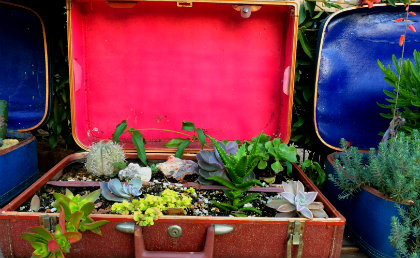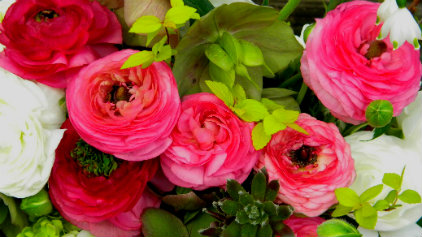
bringing nature, nurseries and gardeners together Nov 1, 2018
Nursery notes: thanks to all for continued support of the Austin
Garden. Because of time constraints, from now until the spring-
time I will be publishing every other Thursday. If I can get some
additional sponsorship it will become weekly again in April.
- Darrel Mayers (editor)
Happy birthday to American Botanical Council For 30 years
Mark Blumenthal and his amazing team have been teaching the
world the ABC's of medicinal herbs. Congratulations!
Food Forest work day and hootenanny: work in Austin's
unique edible food forest at Lady Bird Lake and IH-35, and then
kick back and enjoy some music and food through the afternoon.
Tons of great stuff happening at The Natural Gardener 20% off
all trees through Nov 2 to honor Texas Arbor Day. On Saturday
visit the nursery for the Customer Appreciation Party from 3 -
6 p.m. Live music, free beer, food trucks and festivities. Storewide
10% sale on Saturday. More info here.
Free saplings: available on Saturday from 11 - 2 p.m. at Austin
Subaru (8100 Burnet Road, 78757): TreeFolks

Twenty two Day of the Dead recipes: skull layer cake, cookies,
and pizzas... and maybe some marigold-infused tequila are suggest-
ed by the chefs at Delish to create your Día de Muertos party.❦
____________________________________________________
Marigold bridge: these beauties were on 'double duty' during the
summer brightening the garden and repelling pests, writes Jeff
Spurrier. Now that Day of the Dead is here, marigolds have another
job at hand: 'the petals will get scattered into bright orange pathways
so spirits can follow the trail to an altar stocked with the pleasures
of our material world.' LA Times ❦

Succulents in suitcases: last week down at Cenote coffee shop
(1010 E. Cesar Chavez, 78702) we spotted these charming, portable
miniature gardens.❦
____________________________________________________

 1. Plant a tree: now is still a perfect time to get that shade or orna-
1. Plant a tree: now is still a perfect time to get that shade or orna-
mental tree in the ground.
____________________________________________________
2. Plant flowering perennials: it’s never too late. Even though
their tops will be burned back with the first hard freeze, their roots
will be hardy. During the cool days of winter, they will establish
a healthy root system for a show in the spring.
____________________________________________________
3. Plant some winter blooming annuals: in central Texas, we can
grow pansies, snapdragons, violas, stock, cyclamen, flowering cabb-
age and kale. Remember to work in some organic plant food such
as blood and bone meal. These slow release plant foods will feed
your plants throughout the winter and into the spring. Pansies love
blood meal.
____________________________________________________
4. Plant fall bulbs: there is still plenty of time. There is a great
selection of late winter to early spring flowering bulbs to choose
from. Look for tulips, narcissus, jonquils, muscari, daffodils, ranun-
culus (in photo above) and anemones. Bulbs benefit from the slow
release phosphorus found in bone meal. Mix a tablespoon in the
root zone when\planting. For 'a drift' of any of these flowers, you'll
need 30 or more.
____________________________________________________
5. Force some bulbs indoors: this is a fun activity for Thanksgiv-
ing and Christmas time. The easiest are paperwhite narcissus. Add
some potting mix to a clay or plastic 6” bulb pan (fill about ½ way).
Place 3 to 5 bulbs on top of the soil and add some decorative gravel
to keep them upright and firm. All you need to do now is water the
bulbs in and place the pot in a sunny location. It takes around 3
weeks for the bulbs to force out their foliage and open their flowers.
Easy and decorative.
____________________________________________________
6. Winterize your lawn: use a slow release organic lawn food.
This will give nutrition and strength to your lawn for the coming
cold months.
____________________________________________________
7. Cut back your perennials: do this after the first frost, and mulch
your beds with compost and mulch mixed together. This combinat-
ion will feed the roots while conserving water and warming the bed.
(Average day for first fall frost is November 28.)
____________________________________________________
8. November is onion, scallion, and garlic month. To be success-
ful with these vegetable gems, don’t wait until the days get long
again. Success requires growing in the short days of winter. You can
grow an onion 6” across! Timing is most important.
____________________________________________________
9. Keep on the lookout for a world of fall bedding (annual) plants.
As temperatures cool, we can begin to plant dianthus, snapdragons,
and petunias.
____________________________________________________
10. Watch for black spot and mildew on roses. With cooler
weather, these pesky rose diseases will begin to show up. An or-
ganic spray of Neem oil or wettable sulfur should help in keeping
it at bay. Happy Gardening everyone!
The Austin Garden is sponsored by Hays Free Press

____________________________________________________
Central Texas Gardener: An interview with Susan Morrison,
author of 'The Less is More Garden,' and a visit to a beautiful
cottage garden in Georgetown. Daphne analyzes fungal problems,
and John has tips on planting strawberries. Saturday 4 p.m., Sun-
day 9 a.m. KLRU ❦

Ten Activities for November
by Chris Winslow
mental tree in the ground.
____________________________________________________
2. Plant flowering perennials: it’s never too late. Even though
their tops will be burned back with the first hard freeze, their roots
will be hardy. During the cool days of winter, they will establish
a healthy root system for a show in the spring.
____________________________________________________
3. Plant some winter blooming annuals: in central Texas, we can
grow pansies, snapdragons, violas, stock, cyclamen, flowering cabb-
age and kale. Remember to work in some organic plant food such
as blood and bone meal. These slow release plant foods will feed
your plants throughout the winter and into the spring. Pansies love
blood meal.
____________________________________________________
4. Plant fall bulbs: there is still plenty of time. There is a great
selection of late winter to early spring flowering bulbs to choose
from. Look for tulips, narcissus, jonquils, muscari, daffodils, ranun-
culus (in photo above) and anemones. Bulbs benefit from the slow
release phosphorus found in bone meal. Mix a tablespoon in the
root zone when\planting. For 'a drift' of any of these flowers, you'll
need 30 or more.
____________________________________________________
5. Force some bulbs indoors: this is a fun activity for Thanksgiv-
ing and Christmas time. The easiest are paperwhite narcissus. Add
some potting mix to a clay or plastic 6” bulb pan (fill about ½ way).
Place 3 to 5 bulbs on top of the soil and add some decorative gravel
to keep them upright and firm. All you need to do now is water the
bulbs in and place the pot in a sunny location. It takes around 3
weeks for the bulbs to force out their foliage and open their flowers.
Easy and decorative.
____________________________________________________
6. Winterize your lawn: use a slow release organic lawn food.
This will give nutrition and strength to your lawn for the coming
cold months.
____________________________________________________
7. Cut back your perennials: do this after the first frost, and mulch
your beds with compost and mulch mixed together. This combinat-
ion will feed the roots while conserving water and warming the bed.
(Average day for first fall frost is November 28.)
____________________________________________________
8. November is onion, scallion, and garlic month. To be success-
ful with these vegetable gems, don’t wait until the days get long
again. Success requires growing in the short days of winter. You can
grow an onion 6” across! Timing is most important.
____________________________________________________
9. Keep on the lookout for a world of fall bedding (annual) plants.
As temperatures cool, we can begin to plant dianthus, snapdragons,
and petunias.
____________________________________________________
10. Watch for black spot and mildew on roses. With cooler
weather, these pesky rose diseases will begin to show up. An or-
ganic spray of Neem oil or wettable sulfur should help in keeping
it at bay. Happy Gardening everyone!

